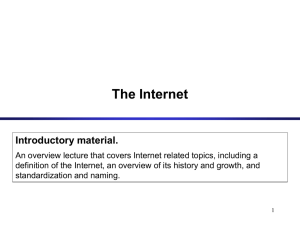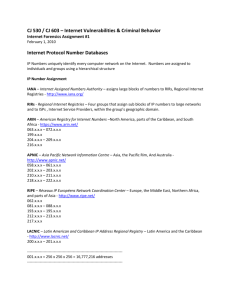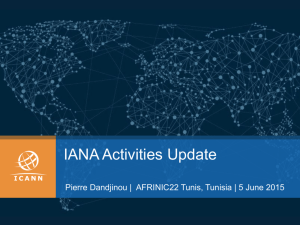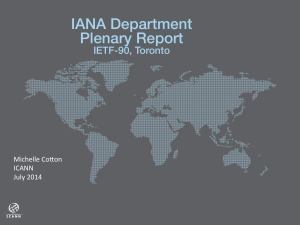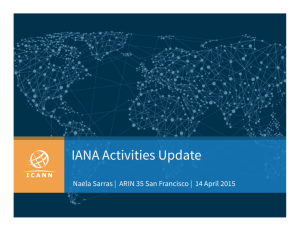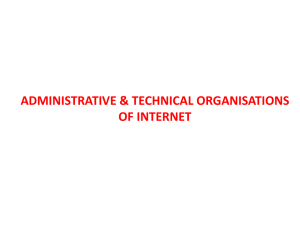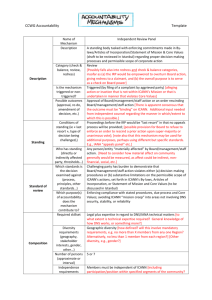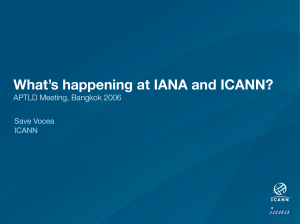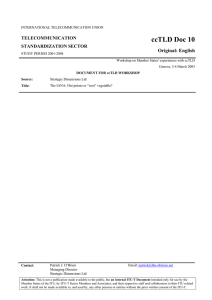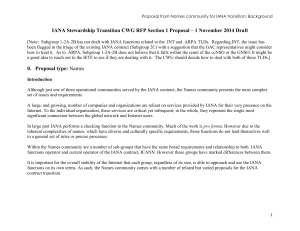The Internet A Definition
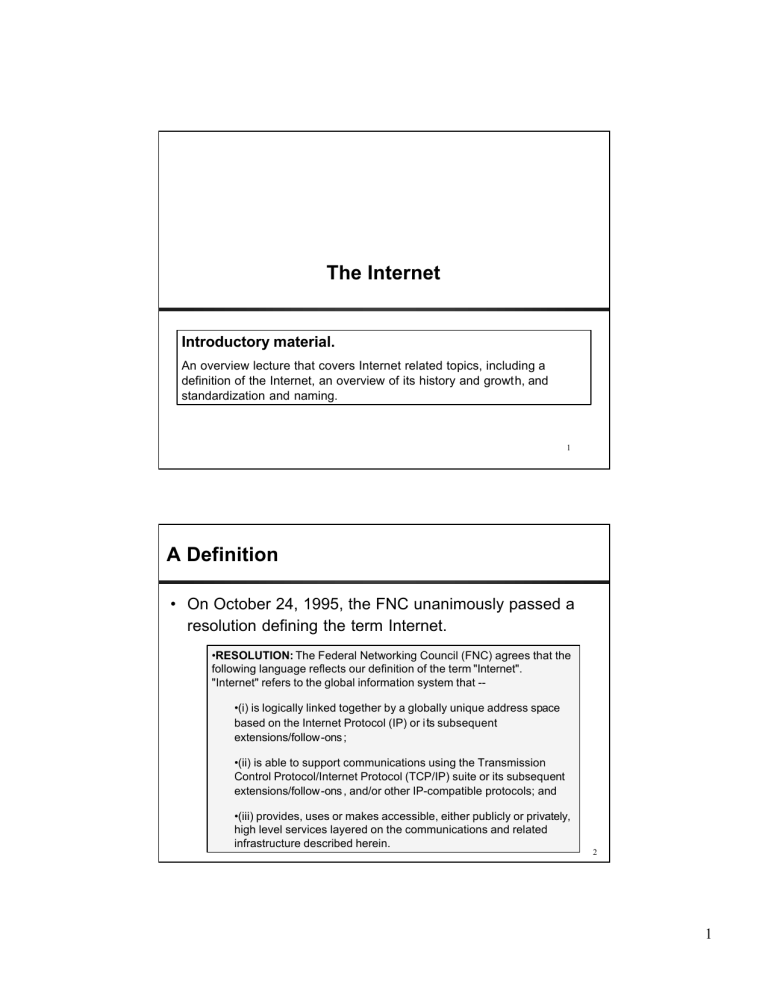
The Internet
Introductory material.
An overview lecture that covers Internet related topics, including a definition of the Internet, an overview of its history and growth, and standardization and naming.
1
A Definition
• On October 24, 1995, the FNC unanimously passed a resolution defining the term Internet.
• RESOLUTION: The Federal Networking Council (FNC) agrees that the following language reflects our definition of the term "Internet".
"Internet" refers to the global information system that --
•(i) is logically linked together by a globally unique address space based on the Internet Protocol (IP) or i t s subsequent extensions/follow-ons ;
•(ii) is able to support communications using the Transmission
Control Protocol/Internet Protocol (TCP/IP) suite or its subsequent extensions/follow-ons , and/or other IP-compatible protocols; and
•(iii) provides, uses or makes accessible, either publicly or privately, high level services layered on the communications and related infrastructure described herein.
2
1
History of the Internet
Mid 1960: Papers on “Packet Switching” emerge.
End 1969s: ARPA sponsors the development of a packet-switching network, called the ARPANET. First four nodes are
UCLA, SRI, U. Utah, UCSB.
1974:
1980:
1983:
The TCP/IP protocols and model are being proposed by
Cerf/Kahn.
IPv4 is introduced
1984:
ARPANET adopts TCP/IP. At this time, the ARPANET has 200 routers.
NSF funds a TCP/IP based backbone network. This backbone grows into the NSFNET, which becomes the successor of the ARPANET.
1995: NSF stops funding of NSFNET. The Internet is completely commercial.
3
Applications of the Internet
• Traditional core applications:
News
Remote Login
File Transfer
• The killer application:
World-Wide Web (WWW)
• New applications:
Videoconferencing
Telephony
P2P applications
Internet Broadcast
4
2
Time Line of the Internet
• Source: Internet Society
5
Growth of the Internet
1000000000
100000000
10000000
1000000
100000
10000
1000
100
Source: Internet Software Consortium
6
3
Internet Infrastructure
Regional
Network local ISP
Backbone Network
IXP
Regional
Network local ISP
Backbone Network
Regional
Network local ISP
IXP
IXP corporate network
Regional
Network campus network
7
Internet Infrastructure
• The infrastructure of the Internet consists of a federation of connected networks that are each independently managed
(“ autonomous system ”)
– Note: Each “autonomous system may consist of multiple IP networks
– Autonomous systems have a number ( AS number )
• Hierarchy of network service providers (NSPs)
– Tier-1 : nation or worldwide network (US: less than 20)
– Tier-2: regional networks (in US: less than 100)
– Tier-3: local Internet service provider (in US: several thousand)
8
4
Internet Infrastructure
• Location where a network (ISP, corporate network, or regional network) gets access to the Internet is called a Point-of-
Presence (POP).
• Locations (Tier-1 or Tier-2) networks are connected for the purpose of exchanging traffic are called peering points .
– Public peering : Traffic is swapped in a specific location, called Internet exchange points (IXPs)
– Private peering: Two networks establish a direct link to each other.
9
Topology of a Tier-1 NSP
10
5
Organization of a single node in a Tier-1 network
m m m m
11
Who is Who on the Internet ?
• Internet Society (ISOC): Founded in 1992, an international nonprofit professional organization that provides administrative support for the Internet. Founded in 1992,
ISOC is the organizational home for the standardization bodies of the Internet.
• Internet Engineering Task Force (IETF): Forum that coordinates the development of new protocols and standards. Organized into working groups that are each devoted to a specific topic or protocol. Working groups document their work in reports, called Request For Comments (RFCs ).
• IRTF (Internet Research Task Force): The Internet Research Task Force is a composed of a number of focused, long-term and small Research Groups.
• Internet Architecture Board (IAB) : a technical advisory group of the Internet
Society, provides oversight of the architecture for the protocols and the standardization process
• The Internet Engineering Steering Group (IESG) : The IESG is responsible for technical management of IETF activities and the Internet standards process.
Standards. Composed of the Area Directors of the IETF working groups.
12
6
Internet Standardization Process
• Working groups present their work i of the Internet are published as RFC (Request for Comments). RFCs are the basis for Internet standards.
• Not all RFCs become Internet Standards ! (There are >3000
RFCs and less than 70 Internet standards)
• A typical (but not only) way of standardization is:
– Internet Drafts
– RFC
– Proposed Standard
– Draft Standard (requires 2 working implementation)
– Internet Standard (declared by IAB)
13
Assigning Identifiers for the Internet
• Who gives the university the domain name “virginia.edu”
• Who assigns it the network prefix “128.143.0.0/16”?
• Who assigns port 80 as the default port for web servers?
• The functions associated with the assignment of numbers is referred to as Internet Assigned Number Authority (IANA).
• IANA used to be managed by Jon Postel at ISI
• Since the 1990s, IP addresses and domain name allocation are delegated to independent organizations. Different organizations are responsible for allocating domain names and IP addresses
14
7
The IANA Function
• The functions associated with the assignment of numbers in the Internet is referred to as Internet Assigned Number
Authority (IANA).
• IANA serves as a registry that keeps records of assigned numbers:
– IP addresses
– Protocol numbers
– Domain names (until 1992)
• There is no charge for allocation.
15
Regional Internet Registries (RIRs)
• Registration and management of IP address is done by Regional Internet
Registries (RIRs)
• Where do RIRs get their addresses from: IANA maintains a high-level registry that distributes large blocks to RIRs
• RIR are administer allocation of:
– IPv4 address blocks
– IPv6 address blocks
– Autonomous system (AS) numbers
• There are currently 4 RIRs worldwide:
– APNIC (Asia/Pacific Region),
– ARIN (North America and Sub-Sahara Africa),
– LACNIC (Latin America and some Caribbean Islands)
– RIPE NCC (Europe, the Middle East, Central Asia, and African countries located north of the equator).
• A fifth regional registry (AfriNIC) is in formation for Africa.
16
8
Transitioning of Domain Name Registration
• Until 1992: Domain name registration done as part of IANA
• 1992: IANA and NSF jointly created InterNIC, a quasi-governmental body mandated to organize and maintain the growing DNS registry and services.
• 1995: InterNIC started charging for domain names ($100 for 2 years)
• 1997: President Clinton directs the Secretary of Commerce to privatize the management of the domain name system (DNS) in a manner that increases competition and facilitates international participation in its management.
• 1998: ICANN was created in response to a policy statement issued by the
US Department of Commerce that called for the formation of a private sector not-for-profit Internet stakeholder to administer policy for the
Internet name and address system. ICANN operates under a renewable 3year contract with the US Department of the Commerce.
– ICANN accredits domain-name registrar for .com, .org., .net (and other domain)
17
ICANN
• The Internet Corporation for Assigned Names and Numbers
(ICANN) is an internationally organized, non-profit corporation that has responsibility for Internet Protocol (IP) address space allocation, protocol identifier assignment, Top-Level Domain name system management, and root server system management functions.
– ICANN performs the IANA functions
– ICANN accredits domain-name registrar for .com, .org.,
.net (and other domain)
• Since ICANN performs the IANA functions, it is in charge for allocating all numbers. However, the main concern is the allocation of domain names.
• ICANN role is to oversee the domain-name registration system's transition from government hands to private hands and to coordinate its decentralization and the integration into a global community.
18
9
